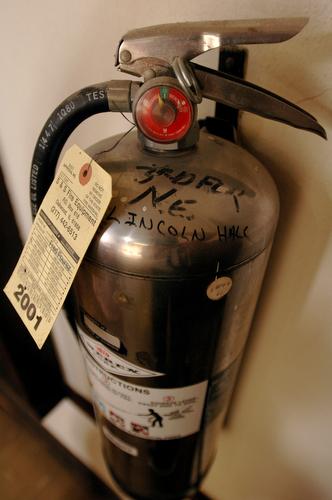Lincoln Hall plan intends to garner ‘green’ reputation

A passed-inspection fire extinguisher hangs on the second floor of Lincoln Hall. In addition to repairs and updates, proposed funding for the building will help make it environmentally friendly. Beck Diefenbach
May 7, 2007
Last updated on May 12, 2016 at 11:52 a.m.
Gov. Rod Blagojevich announced Thursday that the future $66.4 million renovation of Lincoln Hall will be a model “green” project and will be submitted for Leadership in Energy and Environmental Design (LEED) Gold certification.
If certified, the project will be a leader in the national movement for sustainable energy practices, according to Blagojevich’s press release.
The LEED Rating System is a nationally accepted way to judge the design, construction and operation of high performance green buildings.
“A green building is an energy efficient building which is also friendly to the environment and improves the quality of life for those who live or work inside,” said Dave Blanchette, spokesman for the governor’s Capital Development Board.
Get The Daily Illini in your inbox!
There are three levels used to rate the buildings that pass inspection: certified, platinum, gold and silver. If certified, the Lincoln Hall project will be rated “gold,” which is the second highest rating. Ratings are based on a series of goals they set for new construction and major renovations.
“Among the areas they focus on are energy and water use efficiency, indoor air quality, use of recycled materials in the building project, use of local materials, innovative design, reduction of pollution, erosion control and the overall impact of the project on the surrounding environment,” Blanchette said.
The Lincoln Hall project plans to fulfill the goals the system has set while enhancing the classroom environment and preserving the building’s historic character. Although renovators will not be certain about things until the design project is further along, they hope to include energy-saving climate control systems, special insulation and window treatments, energy-conserving lighting systems and water-reducing plumbing fixtures into the building.
“The LEED gold standard and making Lincoln Hall a ‘green’ building will have a positive effect in both the short-term and long-term through more efficient systems that will reduce energy consumption,” said Matthew Tomaszewski, assistant dean of LAS. “The building also will be a visible representation of our campus commitment to reducing energy consumption. With this commitment and future ones, the University serves as an example for others to follow.”
This project is also unique because Lincoln Hall will be one of the first historic buildings in the nation to become Leadership in Energy and Environmental Design certified, Blanchette said.
“This will help people around the country see that a large, historic college building can be made green while preserving its historic character,” he said. “We will have one foot in the past and one foot in the future.”
Chancellor Richard Herman sent an e-mail to the University community Thursday informing them of the measures the University is taking to make the campus more environmentally friendly. In addition to the Lincoln Hall renovations, the University has initiated repair, replacement and remodeling projects across campus to increase energy efficiency. Herman also encouraged students to creatively find ways to conserve energy.
“We are making significant inroads and are laying the foundation for an energy-conscious, sustainable campus,” Herman said in the e-mail.





